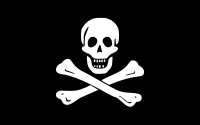Anarchist symbolism
| Part of the Philosophy series on |
| Anarchism |
 |
|
Schools
|
|
Theory · Practice
|
|
Issues
|
|
History
|
|
Culture
|
|
Economics
|
|
By region
|
|
Lists
|
|
Related topics
|
| Anarchism portal Philosophy portal Politics portal |
While anarchists have historically largely denied the importance of symbols to political movement,[1] anarchists have embraced certain symbols for their cause, including most prominently the circle-A and the black flag. Since the revival of anarchism at the turn of the 21st-century concurrent with the rise of the anti-globalization movement, anarchist cultural symbols are widely present.[2]
Contents |
Black flag

The black flag, and the color black in general, have been associated with anarchy since the 1880s. Many anarchist groups contain the word "black" in their names. There have been a number of anarchist periodicals titled Black Flag.
The uniform blackness of this flag is representative of the negation of all oppressive structures. A plain black flag is almost an anti-flag (colourful flags being the usual symbols for nation states). Additionally, a white flag is the universal symbol for surrender to superior force – thus a black flag can be viewed as the polar opposite of surrender.
Historical origins
The black flag represents the absence of a flag, and thus stands in opposition to the very notion of nation-states and hierarchical institutions. In that light, the flag can be seen as a rejection of the concept of representation, or the idea that any person or institution can adequately represent a group of individuals. Modern anarchism has a shared ancestry with - among other ideologies such as liberalism - socialism, a movement strongly associated with the red flag. As anarchism became more and more distinct from socialism in the 1880s, it adopted the black flag in an attempt to differentiate itself. Some anarchists at the time, such as Peter Kropotkin, preferred to continue using the red flag rather than adopt the black.[3] Both the black and red flags first gained notoriety for their use by Buccaneers, who were pirates of French origin operating in the West Indies. The black flag (later the "Jolly Roger") was run up first to indicate that the lives of the crew would be spared if they surrendered. If the crew resisted, the red flag would be displayed to indicate that the offer of amnesty had been withdrawn; no prisoners would be taken.
Subsequent usage
During the French Revolution, the red flag was adopted by the Jacobin Club, whose members controlled the insurrectionary Paris Commune during the assault on the Tuileries, the September Massacres, and throughout the Reign of Terror. In 1831, the black flag was displayed as an emblem of protest during the first Canut revolt, an uprising of silk workers in Lyon; it was also flown in the 1840s during hunger riots, as a symbol of the desperation of the starving urban poor.
It first became associated with anarchism in the 1880s. The French anarchist paper, Le Drapeau Noir ("The Black Flag"), which existed until 1882, is one of the first published references to use black as an anarchist color. Black International was the name of a London anarchist group founded in July 1881. Louise Michel, participant in the Paris Commune of 1871, flew the black flag on March 9, 1883, during demonstration of the unemployed in Paris, France. An open air meeting of the unemployed was broken up by the police and around 500 demonstrators, with Michel at the front carrying a black flag and shouting "Bread, work, or lead!" marched off towards the Boulevard Saint-Germain. The crowd pillaged three baker's shops before the police attacked. Michel was arrested and sentenced to six years solitary confinement. Public pressure soon forced the granting of an amnesty.[4] According to Michel, the "black flag is the flag of strikes and the flag of those who are hungry."[5]
The black flag soon made its way to America. On November 27, 1884, the black flag was displayed in Chicago at an Anarchist demonstration.[6] According to the English Language newspaper of the Chicago anarchists, it was "the fearful symbol of hunger, misery and death."[7]
In the Russian Revolution of 1917, Nestor Makhno's anarchist forces were known collectively as the Black Army. They fought under a black flag with some success until they were crushed by the Red Army (see Black Guards). Emiliano Zapata, a Mexican revolutionary in the 1910s, used a black flag with a skull and crossbones and the Blessed Virgin Mary on it. The flag's slogan was "Tierra y Libertad" ("Land and Liberty"). In 1925, Japanese anarchists formed the Black Youth League, which had branches in the then-colonial Taiwan. In 1945, the group named their journal Kurohata ("Black Flag").
More recently, Parisian students carried black (and red) flags during the massive General Strike of May 1968. In the same year, these flags were seen at the American Students for a Democratic Society national convention. Also at about the same time, the British based journal Black Flag was started, and is still in existence today. Black flags remain a symbol of anarchists today.
Circle-A

The Circle-A is almost certainly the best-known present-day symbol for anarchy. It is a monogram that consists of the capital letter "A" surrounded by the capital letter "O". The letter "A" is derived from the first letter of "anarchy" or "anarchism" in most European languages and is the same in both Latin and Cyrillic scripts. The "O" stands for order. Together they stand for "Anarchy is Order," the first part of a Proudhon quote.[8] This character can be written as Unicode codepoint U+24B6: Ⓐ. In addition, the "@" sign or "(A)" can be used to quickly represent the circle-A on a computer.

Pre-anarchist usage
An early occasion when the encircled A was used was in Stephan Michelspacher book Spiegel der Kunst und Natur (The Mirror of Art and Nature) which was published in Augsburg 1615. This was an Alchemical work strongly influenced by Heinrich Cornelius Agrippa's view of the Kabbalah and magic. Adam McLean describes the centre panel as "two circular diagrams with the German GOTT (the name of God) around the outside, and also the Alpha and Omega @ and the monograph which may be the name of God, Agla.[9] This represents the beginning - alpha - within the end - omega (the first and last letters of the Greek alphabet. This relates to the claim related in the Book of Revelation that Jesus was "the "Alpha and Omega, the beginning and the end, the first and the last" (22.13). Rosicrucian imagery of this type was used by the Golden Dawn. The anarchist (and police spy) Theodor Reuss was associated with William Wynn Westcott, one of the founders of the Golden Dawn, before setting up the Ordo Templi Orientis. Two offshoots of this - Ancient Mystical Order Rosae Crucis and Aleister Crowley's Thelema used the formulation "Do what thou wilt shall be the whole of the Law", which many have taken up as an anarchist slogan.


History of anarchist usage
The first recorded use of the A in a circle by anarchists was by the Federal Council of Spain of the International Workers Association. This was set up by the freemason, Giuseppe Fanelli in 1868.[12] It predates its adoption by anarchists as it was used as a symbol by freemasons amongst others. According to George Woodcock, this symbol was not used by classical anarchists. In a series of photos of the Spanish Civil War taken by Gerda Taro a small A in a circle is visible chalked on the helmet of a militiaman. There is no notation of the affiliation of the militiaman, but one can presume he is an Anarchist. The first documented use was by a small French group, Jeunesse Libertaire ("Libertarian Youth") in 1964. Circolo Sacco e Vanzetti, youth group from Milan, adopted it in and in 1968 it became popular through out Italy. From there it spread rapidly around the world.[13]
The Circle-A and popular culture
As noted above, the circle-A long predates the anarcho-punk movement, which was part of the punk rock movement of the late 1970s. However, the punk movement helped spread the circle-A symbol more widely, and helped raise awareness of it among non-anarchists. This process began with the use of anarchist imagery by the Sex Pistols, though Crass were the first punk band to use the circle-A as well as being the first to espouse serious anarchist views. They had earlier discovered it – then merely an extremely esoteric political emblem – while traveling through France.[14] With time the symbol, and "anarchy" as a vague synonym for rebelliousness, were incorporated into common punk imagery. This led to gradual appearances in mainstream culture over the course of several years, at times far removed from its political origin (described by Situationists as "recuperation"). These appearances typically connected it with anarchy and were intended as sensationalist marketing ploys, playing off of mainstream association of anarchy with chaos. This process mirrored the process of punk subculture coming into the mainstream, which occurred at approximately the same time.
Bisected flags and stars

Various schools within the anarchist movement have adopted their own flags. These flags are bisected diagonally with the right half in black for anarchy and the left half in a color representing each school's ideas. These color templates are also extended to five-pointed stars representing the same schools.
The black-and-yellow or black-and-gold flag is used by anarcho-capitalists. The yellow is intended to symbolise gold, a commodity of exchange often used in marketplaces unrestricted by state intervention. The flag was first used in public in Colorado in 1963 at an event organised by Robert LeFevre.[15]
The black-and-green flag is used by social ecologists, green anarchists, anti-civilization anarchists and anarcho-primitivists. It is generally taken to symbolize a vision of anarchism that focuses on the self-determination of all forms of life (animals, humans, bioregions) and not just humans, hence the green.
The black-and-purple flag is used in association with anarcha-feminism, as is the black-and-pink flag, although the latter is more closely associated with queer anarchists. Unlike other bisected anarchist flags, it does not necessarily represent another form of anarchism, but is used to focus on opposition to the hierarchical patterns of heterosexism, sexism, transphobia, and patriarchy.
The black-and-white flag is used by anarcho-pacifists and, to a lesser extent, Christian anarchists.
Black and red bisected symbolism
The red-and-black flag is the symbol of the anarcho-syndicalist and anarcho-communist movements. Black is the traditional color of anarchism, and red is the traditional color of socialism. The red-and-black flag combines the two colors in equal parts, with a simple diagonal split. Typically, the red section is placed on the top-left corner, with the black on the bottom-right corner of the flag. This symbolizes the co-existence of anarchist and socialist ideals within the anarcho-syndicalism movement, and to symbolize the more socialistic means of the movement leading to a more anarchistic end.

One of the most famous variations of the anarcho-syndicalist flag is that of Spain's Confederación Nacional del Trabajo (National Confederation of Labor, CNT), which still exists today. The CNT, along with the Federación Anarquista Ibérica (Iberian Anarchist Federation, FAI), a major militant faction within the CNT, was a major player in the popular anarchist movements in Spain of the late 19th and early 20th centuries. This group has its own version of the red-and-black flag with its initials on the flag. CNT is in the red, while FAI is in the black – the color of anarchy – as the FAI was founded in 1927 to keep the CNT dedicated to anarchist principles.

Another variation on the red-and-black theme is the red-and-black Africa used mostly by the Zabalaza Anarchist Communist Federation (ZACF or ZabFed), a federation of anarchist groups in South Africa. ZabFed was inspired by the Organisational Platform of the Libertarian Communists. ZabFed members share a basic agreement in terms of theoretical and tactical unity, collective responsibility, and federalism as suggests by the Platform. In historical terms the Platformist tradition starts with The Organizational Platform of the Libertarian Communists, and in the post-war period many include documents like the Georges Fontenis' pamphlet Manifesto of Libertarian Communism.
The symbolism of a united Africa, displayed in traditional anarchist communist colours, is an important one, as a mixture of different demographic groups are represented by Zalabaza in the midst of a societal environment that is otherwise tense with post-colonial racial and sexual issues.
Market anarchism

Ama-gi
The ama-gi is an ancient Sumerian cuneiform word meaning "freedom" or "liberty," the first known usage of the concept in writing. The Ama-gi, while sometimes used as a symbol by anarcho-capitalists, is also used by those who favor more moderate ideologies.[16] Ama-gi literally means "return to the mother," i.e. freed.[17]
Libertatis Æquilibritas

The Libertatis Æquilibritas (Latin for "the Equilibrium of Liberty") is a symbol created by Per Bylund[18] used by some adherents of anarcho-capitalism. It is based on the Circle-A, but symbols such as the yin/yang symbol, and the dollar sign are also present. The Circle-A represents the total liberty and freedom only available in anarchist society, whereas the yin/yang represents the perceived balance of a totally free market. The dollar sign represents capitalism in the free-market sense and the natural right to private property.[19] It serves to distinguish anarcho-capitalists from the rest of the anarchist movement, which largely opposes "capitalism".
Other anarchist symbols
While the black flag and circle-A have been associated with anarchism as a whole, there are various other symbols used by certain groups of anarchists.

Black cat
The black cat, also called the "wild cat" or "sabot-cat", usually with an arched back and with claws and teeth bared, is closely associated with anarchism, especially with anarcho-syndicalism. It was designed by Ralph Chaplin, who was a prominent figure in the Industrial Workers of the World (IWW). As its stance suggests, the cat is meant to suggest wildcat strikes and radical unionism. The IWW (or the Wobblies) was an important industrial union, and was the first American labor union to recruit and organize women and people of color, and played a critical role in the fight for the eight-hour work day and in Free Speech fights all over the country in the early 20th century. Their most famous and influential years were from 1905 until they were largely suppressed by the Palmer Raids.
The origin of the black cat symbol is unclear, but according to one story it came from a IWW strike that was going badly. Several members had been beaten up and were put in a hospital. At that time a skinny, black cat walked into the striker's camp. The cat was fed by the striking workers and as the cat regained its health the strike took a turn for the better. Eventually the striking workers got some of their demands and they adopted the cat as their mascot.[20]
The name Black Cat has been used for numerous anarchist-affiliated collectives and cooperatives, including a well-known music venue in Austin, Texas (which was closed following a July 6, 2002 fire) and a now-defunct "collective kitchen" in the University District of Seattle, Washington.
As a symbol, the black cat has historically been associated with witchcraft, ill omens, and death. It dates back to ancient Hebrew and Babylonian cultures. The witchcraft usage has persisted into modern times; anarchism shares the black cat symbol with witchcraft and Wicca, though the latter two generally do not represent the cat with its back arched in a fighting stance.
Black cross

The Anarchist Black Cross organization's primary goal is to eliminate all prisons. It originated in Tsarist Russia as a support organization for political prisoners. Their symbol is a black cross, with the upwards-facing line being replaced with a raised fist, a symbol also associated with anarchism, defiance of authority, and personal empowerment (black power, youth power, women's liberation, American Indian Movement, International Socialist Organization, 'power to the people', etc...). The fist also represents union, as "many weak fingers can come together to create a strong fist".
The cross is a modification of the Red Cross emblem used by International Red Cross and Red Crescent Movement (founded 1863), the world's largest group of humanitarian organizations. Originally called the Anarchist Red Cross, the name was changed around 1920 to avoid confusion when the Red Cross started organizing relief for prisoners as well. Like the Red Cross, this symbol is not intended to be overtly Christian, though it may be ultimately derived from the Christian cross. The Red Cross and Anarchist Black Cross are humanitarian symbols; the Christian cross is a religious symbol.
Black rose
The Black Rose is a rarely used symbol of the anarchist movement
Black Rose Books is the name of the pre-eminent anarchist bookstore in Montreal and is now the name of a small press imprint headed by anarchist philosopher Dimitrios Roussopoulos.[21] Black Rose was the title of a respected journal of anarchist ideas published in the Boston area during the 1970s, as well as the name of an anarchist lecture series addressed by notable anarchist and libertarian socialists (including Murray Bookchin and Noam Chomsky) into the 1990s.
Jolly Roger/Pirate flag

The Jolly Roger as a black flag with skull and bones has recently gained a popularity among anarchists.
Some claim to use the Jolly Roger as a form of appreciation for the Pirate way of life in freedom and a lack of authority. Many Pirate ships were loosely democratic and most crew mates were working class fugitives from the highly repressive societies in which they were born. Anarchists may find affinity with the concept of pirate utopias, especially the anti-statist and anti-capitalist island of legend, Libertatia. The Libertatian pirates have been identified as precursors to anarchists.[22] Some Internet and techno-anarchists consider themselves pirates due to their free lifestyles in the world of technology and their defiance of copyright laws which is called "pirating". Several articles relating to the connection between anarchism and piracy can be found in the libcom.org library[23]
The Revolutionary Insurrectionary Army of Ukraine, an Anarchist militia, used a variation of the Jolly Roger.

Eat the Rich
A variation of the Jolly Roger the Eat the Rich symbol has been around since at least the 1980s. At first sight it looks like the Jolly Roger, but the crossed bones are replaced by a knife and a fork. It is mostly an anarcho-punk symbol.
The Eat the Rich slogan was popularized within the anarcho-punk community in 1987 by Motörhead's song by that name, and more broadly by the 1993 Aerosmith song of the same name, found on the Get a Grip album. A red t-shirt bearing the "Eat the Rich" symbol was distributed as a promotion for the album.
Wooden shoe

The wooden shoe (also known as clog) was used symbolically by anarchists in the 19th and early 20th century, although it has largely faded from use since then. The French word for wooden shoe, sabot is the probable root of the word sabotage: and refers to the tactic by early Dutch unionists of throwing wooden shoes into the gears of factory or farm machinery, effectively stopping work until the equipment could be repaired. The American analogue of this tactic is "monkeywrenching," referring to the similar practice of throwing a monkeywrench in the machinery to damage it and prevent independent contractors from being able to replace striking union members.
In Philadelphia, Pennsylvania, there is an anarchist bookshop called The Wooden Shoe, and from 2001 to 2003 there was an anarchist magazine in Denmark called Sabot. There is also an American record label focusing primarily on punk-rock and genres revolving around it called Sabot Productions[24], which uses the exact same sabot picture seen on the right as their logo.
See also
- List of symbols
- Red flag
References
- ↑ Iain Mckay, ed. (2008). "Appendix – The Symbols of Anarchy". An Anarchist FAQ. Stirling: AK Press. ISBN 1902593901. OCLC 182529204.
- ↑ Williams, Leonard (September 2007). "Anarchism Revived". New Political Science 29 (3): 297–312. doi:.
- ↑ Kropotkin, Peter, "Act for Yourselves", p. 128
- ↑ George Woodcock, Anarchism, pp. 251-2
- ↑ The Red Virgin: Memoirs of Louise Michel, p. 168
- ↑ Paul Avrich, The Haymarket Tragedy, p. 145
- ↑ quoted by Paul Avrich, The Haymarket Tragedy, p. 144
- ↑ Marshall, Peter. Demanding the Impossible. Fontana, London. 1993. p. 558
- ↑ 'Alchemical Mandala No. 6' by Adam McLean, in The Hermetic Journal No. 6, London, 1979
- ↑ The incorporation of a plumbline is possibly derived from Amos 7:7-9 (King James Version) where it represents a metophorical moral test. Although the plumbline, level and circle all have their place in the symbols of Freemasonry, they are not unique to Freemasonry, and there is no historical reason to associate regular or recognized Freemasonry with this crest or the organization.
- ↑ "The Chicago Corporate Seal". Chicago Public Library. Retrieved on 2008-01-26.
- ↑ 'La Masonería y el movimento obrero' by Alberto Valín Fernández.
- ↑ Woodcock, George. Anarchism: A History Of Libertarian Ideas And Movements. Broadview Press. 2004. p.8
- ↑ The Only Way to Be – Anarchy! by Steve Appleford. LAcitybeat.com Accessed August 30, 2007.
- ↑ Rothbard, Murray N., The Betrayal of the American Right (2007): 188
- ↑ "Library of Economics and Liberty". Retrieved on 2007-03-27.
- ↑ "Journal Homepage of the London School of Economics Hayek Society". Retrieved on 2008-03-11.
- ↑ Per Bylund discusses the new symbol in an article originally published at Anti-State.com, http://www.perbylund.com/the_library_libertatis.htm
- ↑ The New Symbol of Anarchism. Retrieved 27 March 2007.
- ↑ What's this with a black cat & a wooden shoe? What do they have to do with anarchy?
- ↑ Black Rose Books official website. Blackrosebooks.net Accessed August 30, 2007
- ↑ Rediker, Marcus (2004), Villains of All Nations: Atlantic Pirates in the Golden Age, Beacon Press, Beacon, Massachusetts. ISBN 0807050245.
- ↑ libcom library
- ↑ Sabot Productions' Website
External links
- The Symbols of Anarchy from An Anarchist FAQ
- History of anarchist symbols from AnarchyIsOrder.org
- Anarchism Symbols at Anarchism.net
- Anarchism at Flags Of The World
- Anarchism and the History of the Black Flag at the Spunk Library